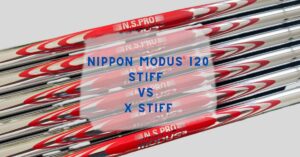Stiff Vs Regular Flex drivers: Demystifying Golf Club Flex
When it comes to golf club shafts, there are a few different flexes to choose from. Two of the most common are stiff and regular flex. But what’s the difference between the two?
The main difference between stiff and regular flex shafts is the amount of bend they have at impact. Stiff flex shafts are designed for golfers with faster swing speeds, while regular flex shafts are designed for golfers with slower swing speeds.
In this blog post, we’ll take a closer look at stiff and regular flex shafts, and we’ll help you decide which one is right for you.
Stiff Vs Regular Flex Drivers: What Are The Differences?

Stiff and regular are two of the most common flexes for golf shafts. The flex of a shaft refers to how much it bends when you swing the club. A stiffer shaft will bend less than a regular shaft and return to its original shape more quickly.
| Aspect | Stiff Flex | Regular Flex |
| Bending | Bends less | Bends more |
| Return to shape | Returns to shape more quickly | Returns to shape more slowly |
| Ball speed | Higher ball speed | Lower ball speed |
| Control | Less control | More control |
| Torque | Less torque | More torque |
| Feel | More responsive | Less responsive |
Bending
When you swing a golf club with a stiffer shaft, it will bend less compared to a regular shaft. This happens because the material used in a stiff shaft is stronger and more resistant to bending.
Imagine a strong tree branch that doesn’t bend much when you push it, compared to a more flexible twig that bends easily.
Similarly, the stiff shaft holds its shape better during the swing, leading to a more stable and predictable clubhead position at impact with the golf ball.
Return To Shape
After the impact, a stiffer shaft will spring back to its original shape more quickly than a regular shaft.
This is because the material in a stiff shaft is more elastic, like a rubber band that quickly bounces back to its original form when stretched.
This rapid return to shape allows the golf club to be ready for the next swing faster, enabling the golfer to maintain a consistent rhythm and tempo in their game.
Ball Speed
A stiffer shaft generally produces higher ball speed when the club strikes the ball. The reason behind this is that the stiffer shaft stores more energy during the downswing, and this energy is then transferred to the golf ball at impact.
It’s similar to a spring being compressed and then released, shooting an object forward with more force. This added energy from the stiffer shaft results in faster ball speed, which can lead to longer shots off the tee and fairway.
Control
While a regular shaft offers more control than a stiff shaft, it’s because of its forgiving nature on off-center hits.
When a golfer strikes the ball away from the center of the clubface (known as mishits), a regular shaft absorbs some of the shock and helps keep the ball’s direction relatively straight.
This forgiving characteristic is especially helpful for beginner and intermediate golfers who may not consistently hit the sweet spot.
On the other hand, a stiffer shaft is less forgiving and requires more precise ball striking to achieve optimal results.
Torque
Torque measures how much the golf shaft twists during the swing. A stiffer shaft has less torque than a regular shaft, meaning it resists twisting more effectively.
Lower torque in a stiffer shaft allows the golfer to have better control over the clubhead’s orientation throughout the swing. This control helps golfers maintain a more consistent swing path and can lead to improved accuracy and shot dispersion.
Feel
Golfers often refer to “feel” when describing how a golf club responds to their swings. A stiffer shaft typically feels more responsive to the golfer’s hands.
This heightened responsiveness is due to the stiffer shaft transmitting more feedback from the clubhead’s movements to the golfer’s hands during the swing.
It’s like the difference between hitting a baseball with a solid bat versus a hollow plastic bat—the solid bat provides more sensation and feedback upon contact.
This enhanced feel in a stiffer shaft can give golfers a better sense of the club’s position throughout the swing, aiding in shot-making decisions and overall performance.
Stiff Vs Regular Flex: What Are The Similarities?

Stiff and regular flex shafts are two of the most common shaft flexes used in golf clubs. They are both designed to provide a good balance of control and power, but there are some key differences between them.
Both Shafts Designed For Average Swing Speeds
Both the stiffer and regular shafts are carefully engineered to suit golfers with average swing speeds.
This means that they are optimized to work well for players who typically generate moderate clubhead speed during their swings.
The shafts are designed to provide the right amount of flex and responsiveness, ensuring that golfers can achieve optimal performance and distance without requiring an extremely fast or slow swing speed.
Good Balance Of Control And Power
Both types of shafts offer a balanced combination of control and power. Golfers need control to ensure their shots stay accurate and on target, while power is essential for achieving distance and maximizing the potential of each swing.
The manufacturers carefully consider the materials, design, and flex profiles of both shafts to achieve this delicate balance, allowing golfers to feel confident in their shots and play their best game on the course.
Variety Of Lengths And Weights For Different Golfers
Whether a golfer is tall or short, strong or less so, both shaft types come in a variety of lengths and weights. This customization allows golfers to find the ideal fit for their unique physique and swing characteristics.
Choosing the right length and weight ensures that the golfer can maintain proper form and mechanics, leading to more consistent and successful shots during their rounds.
Steel Or Graphite Construction
Both shafts are available in two popular materials: steel and graphite. Steel shafts are generally heavier and offer a more traditional feel, providing stability and control.
On the other hand, graphite shafts are lighter, promoting increased swing speed and potential distance.
Golfers can select the material that best suits their preferences and playing style, ensuring a comfortable and enjoyable experience on the course.
Stiff Vs Regular Flex: Which One Is Better?

The choice between stiff and regular flex in golf clubs depends on the player’s swing speed and preferences.
Stiff shafts are designed for golfers with faster swing speeds, providing more control and accuracy, but requiring greater power to compress the shaft during the swing fully.
On the other hand, regular flex shafts are more suitable for players with slower swing speeds, as they offer increased forgiveness and easier clubhead launch.
Determining which one is better boils down to individual factors. If you possess a faster swing speed and desire precise shot-making, a stiff flex might be preferable.
Conversely, a regular flex could yield better results if you have a slower swing speed. Ultimately, personal testing and consultation with a golf professional can help make the ideal selection.
Frequently Asked Questions
If you’re a golfer or into sports involving flexible equipment, you’ve probably encountered the terms “stiff” and “regular” flex when choosing clubs or gear.
Understanding the differences can greatly impact your performance. Here are some FAQs to help you.
Which Type Of Golfer Benefits From Stiff Flex?
Golfers with faster swing speeds, stronger players, or those seeking precision and distance usually benefit from stiff flex shafts.
Who Should Use Regular Flex?
Players with slower swing speeds or those looking for more forgiveness and higher ball flight typically prefer regular flex shafts.
How Does The Shaft’s Flex Affect Ball Trajectory?
Stiff flex tends to produce lower ball flights, while regular flex often results in higher ball trajectories.
Is There A Significant Difference In Distance Between The Two Flexes?
Depending on swing speed and player skill, distance variations can occur. Stiff flex might yield slightly more distance for some players, but individual performance varies.
Can A Player Switch Between Flexes Easily?
Switching flexes can affect performance. Golfers should undergo a proper fitting to determine which flex suits their swing before making any changes.
Are There Any Swing Speed Guidelines For Choosing Between Stiff And Regular Flex?
Generally, a swing speed of 90 mph or higher leans towards stiff flex, while a speed below 90 mph aligns with regular flex. But fitting is crucial for personalized results.
Are These Flex Types Limited To Golf Clubs Only?
No, shaft flexes apply to various sports equipment, such as tennis rackets, hockey sticks, and archery bows, influencing the overall performance of the gear.


![Are Ping Tour Black 2.0 Good Drivers? [Myth Or Real] Are-Ping-Tour-Black-2.0-Good-Drivers](https://giftedgolfers.com/wp-content/uploads/2023/05/Are-Ping-Tour-Black-2.0-Good-Drivers-300x157.jpg)



